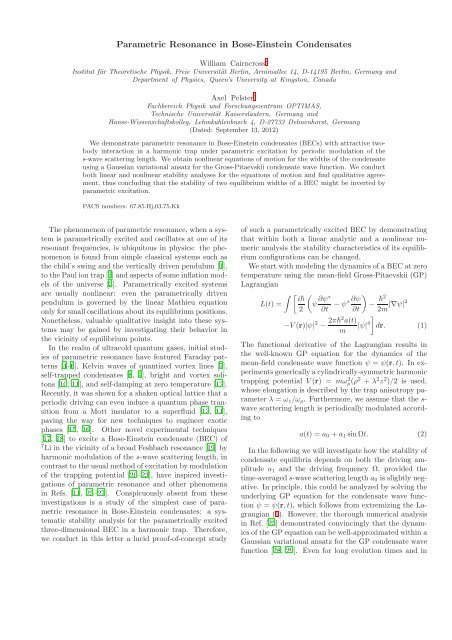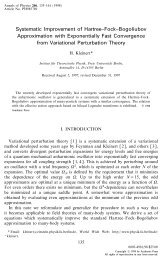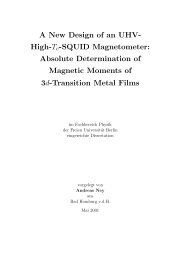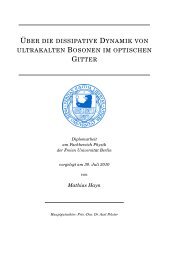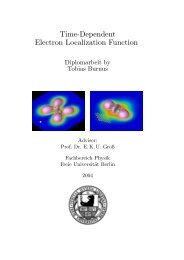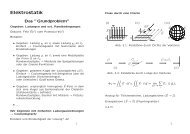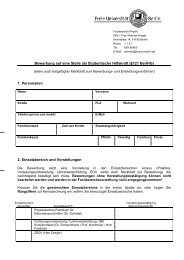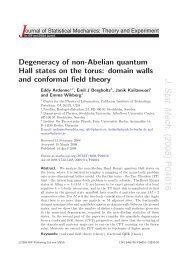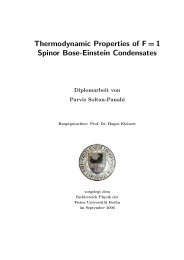Technical University Kaiserslautern Preprint - Fachbereich Physik ...
Technical University Kaiserslautern Preprint - Fachbereich Physik ...
Technical University Kaiserslautern Preprint - Fachbereich Physik ...
You also want an ePaper? Increase the reach of your titles
YUMPU automatically turns print PDFs into web optimized ePapers that Google loves.
Parametric Resonance in Bose-Einstein Condensates<br />
William Cairncross ∗<br />
Institut für Theoretische <strong>Physik</strong>, Freie Universität Berlin, Arnimallee 14, D-14195 Berlin, Germany and<br />
Department of Physics, Queen’s <strong>University</strong> at Kingston, Canada<br />
Axel Pelster †<br />
<strong>Fachbereich</strong> <strong>Physik</strong> und Forschungszentrum OPTIMAS,<br />
Technische Universität <strong>Kaiserslautern</strong>, Germany and<br />
Hanse-Wissenschaftskolleg, Lehmkuhlenbusch 4, D-27733 Delmenhorst, Germany<br />
(Dated: September 13, 2012)<br />
We demonstrate parametric resonance in Bose-Einstein condensates (BECs) with attractive twobody<br />
interaction in a harmonic trap under parametric excitation by periodic modulation of the<br />
s-wave scattering length. We obtain nonlinear equations of motion for the widths of the condensate<br />
using a Gaussian variational ansatz for the Gross-Pitaevskii condensate wave function. We conduct<br />
both linear and nonlinear stability analyses for the equations of motion and find qualitative agreement,<br />
thus concluding that the stability of two equilibrium widths of a BEC might be inverted by<br />
parametric excitation.<br />
PACS numbers: 67.85.Hj,03.75.Kk<br />
The phenomenon of parametric resonance, when a system<br />
is parametrically excited and oscillates at one of its<br />
resonant frequencies, is ubiquitous in physics: the phenomenon<br />
is found from simple classical systems such as<br />
the child’s swing and the vertically driven pendulum [1],<br />
tothePauliontrap[2]andaspectsofsomeinflationmodels<br />
of the universe [3]. Parametrically excited systems<br />
are usually nonlinear: even the parametrically driven<br />
pendulum is governed by the linear Mathieu equation<br />
onlyfor smalloscillationsabout its equilibrium positions.<br />
Nonetheless, valuable qualitative insight into these systems<br />
may be gained by investigating their behavior in<br />
the vicinity of equilibrium points.<br />
In the realm of ultracold quantum gases, initial studies<br />
of parametric resonance have featured Faraday patterns<br />
[4–6], Kelvin waves of quantized vortex lines [7],<br />
self-trapped condensates [8, 9], bright and vortex solitons<br />
[10, 11], and self-damping at zero temperature [12].<br />
Recently, it was shown for a shaken optical lattice that a<br />
periodic driving can even induce a quantum phase transition<br />
from a Mott insulator to a superfluid [13, 14],<br />
paving the way for new techniques to engineer exotic<br />
phases [15, 16]. Other novel experimental techniques<br />
[17, 18] to excite a Bose-Einstein condensate (BEC) of<br />
7 Li in the vicinity of a broad Feshbach resonance [19] by<br />
harmonic modulation of the s-wave scattering length, in<br />
contrastto the usual method of excitation by modulation<br />
of the trapping potential [20–23], have inspired investigations<br />
of parametric resonance and other phenomena<br />
in Refs. [11, 25–27]. Conspicuously absent from these<br />
investigations is a study of the simplest case of parametric<br />
resonance in Bose-Einstein condensates: a systematic<br />
stability analysis for the parametrically excited<br />
three-dimensional BEC in a harmonic trap. Therefore,<br />
we conduct in this letter a lucid proof-of-concept study<br />
of such a parametrically excited BEC by demonstrating<br />
that within both a linear analytic and a nonlinear numeric<br />
analysis the stability characteristics of its equilibrium<br />
configurations can be changed.<br />
We start with modeling the dynamics of a BEC at zero<br />
temperature using the mean-field Gross-Pitaevskii (GP)<br />
Lagrangian<br />
∫ [ i<br />
L(t) =<br />
(ψ ∂ψ∗ −ψ ∗∂ψ<br />
)− 2<br />
2 ∂t ∂t 2m |∇ψ|2<br />
]<br />
−V(r)|ψ| 2 − 2π2 a(t)<br />
m |ψ|4 dr. (1)<br />
The functional derivative of the Lagrangian results in<br />
the well-known GP equation for the dynamics of the<br />
mean-field condensate wave function ψ = ψ(r,t). In experimentsgenericallyacylindrically-symmetricharmonic<br />
trapping potential V(r) = mω 2 ρ (ρ2 + λ 2 z 2 )/2 is used,<br />
whose elongation is described by the trap anisotropy parameter<br />
λ = ω z /ω ρ . Furthermore, we assume that the s-<br />
wave scattering length is periodically modulated according<br />
to<br />
a(t) = a 0 +a 1 sinΩt. (2)<br />
In the following we will investigate how the stability of<br />
condensate equilibria depends on both the driving amplitude<br />
a 1 and the driving frequency Ω, provided the<br />
time-averageds-wave scattering length a 0 is slightly negative.<br />
In principle, this could be analyzed by solving the<br />
underlying GP equation for the condensate wave function<br />
ψ = ψ(r,t), which follows from extremizing the Lagrangian<br />
(1). However, the thorough numerical analysis<br />
in Ref. [25] demonstrated convincingly that the dynamicsofthe<br />
GPequationcanbe well-approximatedwithin a<br />
Gaussian variational ansatz for the GP condensate wave<br />
function [28, 29]. Even for long evolution times and in
2<br />
the vicinity of resonances, where oscillations of the condensate<br />
are quite large, it was possible to reduce the GP<br />
partial differential equation to a set of ordinary differential<br />
equations for the variational parameters.<br />
Therefore, we follow the latter approach and employ<br />
the Gaussian ansatz<br />
]<br />
ψ G (ρ,z,t) = N(t)exp<br />
[− ρ2<br />
+iρ 2 φ ρ<br />
2ũ 2 ρ<br />
]<br />
×exp<br />
[− z2<br />
2ũ 2 +iz 2 φ z , (3)<br />
z<br />
with time-dependent variational widths ũ ρ , ũ z , phases<br />
φ ρ , φ z , andnormalizationN(t) = N 1/2 π 3/2 ũ −1<br />
ρ ũ−1/2 z .Inserting<br />
the Gaussian ansatz (3) into the GP Lagrangian<br />
(1) and extremizing with respect to all variational parameters,<br />
we obtain at first explicit expressions for the<br />
phases φ ρ,z = m˙ũ ρ,z /(2ũ ρ,z ). We define the dimensionless<br />
time τ = ω ρ t and scale the variational widths<br />
by u ρ,z = ũ ρ,z /a ho , where a ho = √ /(mω ρ ) is the harmonic<br />
oscillator length. Finally, we write the dimensionless<br />
driving function p(τ) = p 0 +p 1 sin(Ωτ/ω ρ ) according<br />
to the definitions p 0,1 = √ 2/πNa 0,1 /a ho . The resulting<br />
dynamics for the widths u ρ and u z is then determined<br />
by a pair of coupled nonlinear ordinary differential equations:<br />
ü ρ +u ρ = 1 u 3 ρ<br />
ü z +λ 2 u z = 1 u 3 z<br />
+ p(τ)<br />
u 3 ρu z<br />
,<br />
+ p(τ)<br />
u 2 ρu 2 . (4)<br />
z<br />
For attractive two-body interactions, there exists a<br />
critical value of the time-averaged interaction strength<br />
p crit<br />
0 (λ) < 0 beyond which no equilibria exist in the absence<br />
of parametric driving. Its dependence on the trap<br />
anisotropy λ must be evaluated numerically, as for example<br />
in Ref. [27]. For p crit<br />
0 (λ) < p 0 < 0, there exists a<br />
pair ofequilibrium points for Eqs. (4), one stable and one<br />
unstable [28, 29], which we denote with u 0+ and u 0− , respectively.<br />
Weremarkthatthe stabilityofthesepointsin<br />
the absence of parametric driving is determined by evaluating<br />
the frequencies of collective modes for small oscillations<br />
about equilibrium [27]. Whereas the equilibrium<br />
u 0+ hasrealfrequenciesforallmodesand, thus, is stable,<br />
the equilibrium u 0− possessesanimaginaryfrequencyfor<br />
one mode, implying exponential behaviour and thus instability.<br />
In view of a linear stability analysis we assume small<br />
oscillations about an equilibrium, write u ρ ≈ u ρ0 + δu ρ<br />
and u z ≈ u z0 + δu ρ , and expand the nonlinear terms<br />
of Eqs. (4) to first order in δu ρ and δu z . We scale and<br />
translate time as 2t ′ +π/2 = Ωτ/ω ρ , define displacement<br />
and forcing vectors x(t ′ ) and f,<br />
( ) ⎛<br />
p<br />
δuρ (τ) (<br />
x(t ′ ωρ<br />
)<br />
1<br />
⎞<br />
2 u<br />
) = , f = 4 ⎝<br />
3 ρ0 uz0<br />
⎠, (5)<br />
δu z (τ) Ω<br />
p 1<br />
u 2 ρ0 u2 z0<br />
and finally we introduce the matrices A and Q corresponding<br />
to constant and periodic coefficients, respectively:<br />
A = 4<br />
Q = −2<br />
⎛<br />
( ωρ<br />
) 2<br />
⎝<br />
Ω<br />
⎛<br />
( ωρ<br />
) 2<br />
⎝<br />
Ω<br />
4<br />
2p 0<br />
u 3 ρ0 u2 z0<br />
p 0<br />
u 3 ρ0 u2 z0<br />
3λ 2 + 1<br />
u 4 z0<br />
3<br />
u 4 ρ0 uz0 1<br />
u 3 ρ0 u2 z0<br />
2<br />
u 3 ρ0 u2 z0<br />
2<br />
u 2 ρ0 u3 z0<br />
⎞<br />
⎞<br />
⎠,<br />
⎠. (6)<br />
The result is a set of coupled, asymmetric, inhomogeneous<br />
Mathieu equations,<br />
ẍ(t ′ )+(A−2p 1 Qcos2t ′ )x(t ′ ) = f cos2t ′ , (7)<br />
whose solutions determine whether the underlying equilibrium<br />
is stable or unstable.<br />
The Mathieu equation, a special case of Hill’s differential<br />
equation [30], has been studied extensively in the<br />
literature [31]: approaches to obtaining the equation’s<br />
stability diagram include continued fractions [30, 32, 33],<br />
perturbative methods [34–36], and infinite determinant<br />
methods [37–40]. The problem has been treated in great<br />
detail in Ref. [41] for the study of the Paul trap, the stability<br />
of which is governed exactly by a set of coupled<br />
homogeneous Mathieu equations. Of importance to our<br />
particular problem are Refs. [42, 43], where it was shown<br />
that for both single and coupled Mathieu equations, an<br />
inhomogeneous term does not affect the location of stability<br />
borders to Eq. (7). In the following, we choose the<br />
concisecontinued-fractionmethod basedontheapproach<br />
of Refs. [32, 33].<br />
The π-periodic parametric driving of the Mathieu<br />
equation permits the application of Floquet theory, the<br />
essential statement of which is that each of the two fundamental<br />
solutions x 1,2 (t ′ ) to Eq. (7) may be written in<br />
the form [44]<br />
x 1,2 (t ′ ) = e ±βt′<br />
∞ ∑<br />
n=−∞<br />
b 2n e 2int′ , (8)<br />
where the π-periodic part consists of Fourier components<br />
b 2n and the exponential part is characterized by the Floquet<br />
exponent β, which determines the stability of the<br />
solution. Due to the presence of both signs of the exponent<br />
in a general solution, we require for stability that<br />
R[β] = 0. On the stability borders, solutions to the<br />
Mathieu equation are mπ-periodic with m ∈ Z. Thus to<br />
obtain the stability borders, we set β = mi in Eq. (8).<br />
By substitution of the Floquet ansatz(8) into Eq. (7), we<br />
obtain a third-order recurrence relation for the Fourier<br />
coefficients b 2n :<br />
[ ]<br />
A+(β +2in) 2 I b 2n −p 1 Q(b 2n+2 +b 2n−2 ) = 0. (9)
3<br />
We define the ladder operators S ± 2n b 2n = b 2n±2 as<br />
S ± 2n = {A+[β +2i(n+1)] 2 I−p 1 QS ± 2n±2} −1p1<br />
Q,<br />
(10)<br />
and by repeated re-substitution of these ladder operators<br />
into the recursion relation (9) for n increasing and<br />
decreasing from zero, we obtain a tri-diagonal matrixvalued<br />
continued fraction relating the parameters A, Q,<br />
and β:<br />
( { [ ] −1<br />
A+β 2 I−p 2 1 Q A+(β +2i) 2 −...<br />
[ ] } ) −1<br />
+ A+(β −2i) 2 −... Q b 0 = 0. (11)<br />
In order to obtain a non-trivial solution for b 0 , the<br />
determinant of the matrix-valued continued fraction in<br />
Eq. (11) must vanish. The resulting stability for a particular<br />
value of the modulation frequency Ω and the dimensionless<br />
driving amplitude p 1 is then shown in the<br />
linear stability diagram of Fig. 1 for three characteristic<br />
values of the trap anisotropy λ. Our results indicate that<br />
for the unstable (stable) equilibrium position, the largest<br />
regionofstability (instability) occursforapancakeBEC,<br />
i.e., for λ > 1.<br />
As a special case the stability borders for the isotropic<br />
condensate are given by a separate continued fraction,<br />
obtained by an analogous process for a single inhomogeneous<br />
Mathieu equation. The resulting stability diagrams<br />
are shown in Fig. 2. It allows to draw a direct<br />
analogy between the isotropic condensate and the parametrically<br />
driven pendulum: the pendulum too is described<br />
by a single Mathieu equation, however the inhomogeneous<br />
term in the equation of motion for the BEC<br />
corresponds to a direct periodic driving in phase with<br />
the parametric driving. It was shown in Ref. [42] that<br />
a periodic inhomogeneity has no effect on the stability<br />
borders for a single Mathieu equation, so Fig. 2 is simply<br />
a transformation of the standard Ince-Strutt stability diagram<br />
for the parametrically driven pendulum [30], for<br />
the relevant experimental parameters of the BEC.<br />
Whiletheresultsoflinearstabilityanalysisforthecoupled<br />
Mathieu system are qualitatively similar to those<br />
for the single equation, there are a number of notable<br />
changes between Figs. 1 and 2. First, for the coupled<br />
Mathieu equations, there exist a set of stability regions<br />
not attainable by the analytic method used here. These<br />
are displayed without black borders in Fig. 1, and correspond<br />
to the so-called “combined resonances” of the system<br />
[39, 41]. These regions are attainable by numerical<br />
stability analysis of the Mathieu equations [41, 44, 45],<br />
which was used to generate the colored background regions<br />
of Fig. 1. It is notable in Fig. 1 that these anomalous<br />
regions are not present for λ = 1.<br />
A second and important difference from the single to<br />
the coupled Mathieu equations is the appearance of a<br />
(a)<br />
(b)<br />
(c)<br />
FIG. 1. Linear stability diagrams for the unstable (case 1)<br />
and stable (case 2) equilibrium positions of a cylindricallysymmetric<br />
BEC for three values of the trap anisotropy λ: (a)<br />
λ = 0.2 (a cigar-shaped BEC), (b) λ = 1 (spherical BEC),<br />
and (c) λ = 2.6 (pancake-shaped BEC). White regions correspond<br />
to unstable solutions, darkest shaded regions to stable<br />
solutions, and lightly shadedregions correspond tomarginally<br />
stable solutions – regions where only one of two available collective<br />
oscillation modes is stable.<br />
new region, shaded white and issuing from Ω/ω ρ ≈ 10 in<br />
Fig. 1 for λ = 1, case 1. This region is identified with the<br />
instability of the quadrupole collective mode, which does<br />
not appear in a one-dimensional analysis. This result<br />
implies that a three-dimensional analysis might result in<br />
further changes to the linear stability diagram of Fig. 1<br />
for λ = 1, case 1.<br />
As the underlying equations of motion (4) are inherently<br />
nonlinear, a linear analytic stability analysis alone<br />
is not sufficient to investigate the phenomenon of parametric<br />
resonance. Therefore, we have also performed a<br />
detailed numerical stability analysis by integrating the<br />
equations of motion (4) over a long time-period using a<br />
Runge-Kutta-Verner 8(9) order algorithm, incrementing<br />
through pairs (p 1 ,Ω) and recording divergent solutions<br />
to obtain the corresponding stability diagram. The corresponding<br />
results are shown in Fig. 3 for the same three<br />
values of the trap anisotropy λ as in Fig. 1.
4<br />
(a)<br />
FIG. 2. Linear stability diagrams for (a) unstable and (b)<br />
stable equilibria of an isotropic BEC. Shaded and white regions<br />
indicate stable and unstable solutions, respectively. The<br />
presence of a stable region in (a) indicates that an originally<br />
unstable equilibrium might be stabilized by parametric excitation.<br />
(b)<br />
The results for the originally stable equilibrium u 0+<br />
show both qualitative and even quantitative similarity<br />
to the linear stability analysis of Fig. 1, i.e., a similar<br />
tonguelike structure of unstable regions issuing from certain<br />
points on the vertical axis. The originally unstable<br />
equilibrium u 0− also shows qualitative similarity to the<br />
linear analysis of Fig. 1, however the region of stability<br />
begins only for much larger modulation frequency Ω<br />
and dimensionless driving amplitude p 1 . These results<br />
are both reasonable, as the linear stability analysis is<br />
only valid for small oscillations – corresponding to large<br />
(p 1 ,Ω) for equilibrium u 0+ and small (p 1 ,Ω) for equilibrium<br />
u 0− . Furthermore, in contrast to Fig. 1, we find<br />
in the nonlinear stability diagram of Fig. 3 that stability<br />
is more easily achieved for a cigar-shaped BEC, i.e., for<br />
λ < 1.<br />
Further comparison of the linear and nonlinear stability<br />
diagrams of Figs. 1 and 3 shows the possibility of<br />
both simultaneous stability of the equilibrium positions,<br />
and even the possibility of a complete reversal of the<br />
stability characteristics. In the latter case, the smaller<br />
equilibrium position would become the only stable width<br />
of the condensate, which should be experimentally observable.<br />
A final observation, applicable to the originally<br />
unstable equilibrium in both linear and nonlinear<br />
cases, is the existence of a minimum driving amplitude<br />
p min<br />
1 necessary to stabilize the condensate. The value<br />
p min<br />
1 = u 0 (5u 4 0−1) ≈ 0.17 p 0 is exactly attainable for the<br />
linearanalysisoftheisotropiccondensate, andinFig.1is<br />
approximately independent of λ in the considered range<br />
[0.2,2.6]. For the nonlinear analysis, p min<br />
1 ≈ 1.2 p 0 is also<br />
approximately independent of λ. This feature will have<br />
implications for an experiment, as in conjunction with<br />
the width of the Feshbach resonance, it dictates the minimum<br />
modulation of the applied magnetic field necessary<br />
to stabilize the condensate.<br />
(c)<br />
FIG. 3. Nonlinear stability diagrams for the unstable (left)<br />
andstable(right)equilibriaofacylindrically-symmetricBEC,<br />
for three values of the trap anisotropy λ: (a) λ = 0.2 (a cigarshaped<br />
BEC), (b) λ = 1 (spherical BEC), and (c) λ = 2.6<br />
(pancake BEC).<br />
Wenotethatanystabilitydiagramdependsontheparticular<br />
choice for the time-averaged dimensionless interaction<br />
strength p 0 . The concrete resultsin Figs. 1–3were<br />
obtained for the particular value p 0 = 0.9 p crit<br />
0 (λ). As p 0<br />
approaches p crit<br />
0 (λ), we generically observe a growth of<br />
the stable (unstable) regions in case 1 (2).<br />
Finally, we conclude that our proof-of-concept investigation<br />
has unambiguously shown that the phenomenon<br />
ofparametricresonanceshouldbeexperimentallyobservable<br />
also for Bose-Einstein condensation. However, due<br />
to the intrinsic nonlinear nature of the underlying GP<br />
mean-field theory, a linear analysis, like in the Paul trap,<br />
is not sufficient to quantitatively study the stability diagram.<br />
Thus, in order to achieve a destabilization (stabilization)<br />
of a stable (unstable) BEC equilibrium in an<br />
experiment, a corresponding numerical nonlinear analysisisindispensable.<br />
Regardless,alinearstability analysis<br />
providesanintuitiveandqualitativeunderstandingofthe<br />
physics of parametric resonance in BECs.<br />
In the present letter we have focused our attention<br />
upon a periodic modulation of the s-wave scattering<br />
length around a slightly negative value, which restricts
5<br />
the number of particles in a BEC to the order of a few<br />
thousand [46, 47]. However, the phenomenon of parametric<br />
resonance might be more important for dipolar<br />
BECs, where in addition to a repulsive short-range and<br />
isotropic interaction, also a long-range and anisotropic<br />
dipolar interaction between atomic magnetic or molecular<br />
dipoles is present. Provided that the dipolar interaction<br />
is smaller than the contact interaction, a stable<br />
dipolar BEC does exist. But a larger dipolar strength<br />
leads to mutual existence of both a stable and an unstabledipolarBEC[48]whosestabilitymightbechangedvia<br />
a periodic modulation of the harmonic trap frequencies<br />
or the s-wave scattering length. In that context it might<br />
also be of interest to estimate how quantum fluctuations,<br />
which are non-negligible for a larger dipolar interaction<br />
strength [49], change the stability diagram. The case<br />
for dipolar Fermi gases is probably even more interesting<br />
from the point of view of parametric resonance, as for<br />
any dipolar strength a stable equilibrium coexists with<br />
an unstable one [50]. Thus, parametric resonance may<br />
offer a simple efficient approach for realizing equilibria of<br />
dipolar quantum gases whose properties have so far not<br />
yet been explored.<br />
We are grateful to Jochen Brüggemann for discussions<br />
and Antun Balažfor his valuable input. This project was<br />
supported by the DAAD (German Academic Exchange<br />
Service) within the program RISE (Research Internships<br />
in Science and Engineering).<br />
∗ william.cairncross@queensu.ca<br />
† http://www.physik.fu-berlin.de/~pelster<br />
[1] R.P. Feynman, R.B. Leighton, and M. Sands, The Feynman<br />
Lectures on Physics, Vol. 1 (Addison-Wesley, New<br />
York, 1964).<br />
[2] W. Paul, Angew. Chem. Int. Ed. Engl. 29, 739 (1990).<br />
[3] L. Kofman, A. Linde and A.A. Starobinsky, Phys. Rev.<br />
Lett. 73, 3195 (1994).<br />
[4] K. Staliunas, S. Longhi, and G.J. de Valcárcel, Phys.<br />
Rev. Lett. 89, 210406 (2002).<br />
[5] P. Capuzzi, M. Gattobigio, and P. Vignolo, Phys. Rev.<br />
A 83, 013603 (2011).<br />
[6] A. Balaz and A.I. Nicolin, Phys. Rev. A 85, 023613<br />
(2012).<br />
[7] T.P. Simula, T. Mizushima, and K. Machida, Phys. Rev.<br />
Lett. 101, 020402 (2008).<br />
[8] H. Saito, R.G. Hulet, and M. Ueda, Phys. Rev. A 76,<br />
053619 (2007).<br />
[9] F.Kh. Abdullaev, J.G. Caputo, R.A. Kraenkel, and B.A.<br />
Malomed, Phys. Rev. A 67, 013605 (2003).<br />
[10] H. Saito and M. Ueda, Phys. Rev. Lett. 90, 040403<br />
(2003).<br />
[11] S.K. Adhikari, Phys. Rev. A 69, 063613 (2004).<br />
[12] Y. Kagan and L.A. Maksimov, Phys. Rev. A 64, 053610<br />
(2001).<br />
[13] A. Eckardt, C. Weiss, and M. Holthaus, Phys. Rev. Lett.<br />
95, 260404 (2005).<br />
[14] A. Zenesini, H. Lignier, D. Ciampini, O. Morsch, and E.<br />
Arimondo, Phys. Rev. Lett. 102, 100403 (2009).<br />
[15] J. Struck, C. Olschlager, R. Le Targat, P. Soltan-Panahi,<br />
A. Eckardt, M. Lewenstein, P. Windpassinger, and K.<br />
Sengstock, Science 333, 996 (2011).<br />
[16] J. Struck, C. Olschlager, M. Weinberg, P. Hauke, J. Simonet,<br />
A. Eckardt, M. Lewenstein, K. Sengstock, and P.<br />
Windpassinger, Phys. Rev. Lett. 108, 225304 (2012).<br />
[17] E. R. F. Ramos and E. A. L. Henn and J. A. Seman<br />
and M. A. Caracanhas and K. M. F. Magalhães and<br />
K. Helmerson and V. I. Yukalov and V. S. Bagnato,<br />
Phys. Rev. A 78, 063412 (2008).<br />
[18] S.E. Pollack, D. Dries, R.G. Hulet, K.M.F. Magalhães,<br />
E.A.L. Henn, E.R.F. Ramos, M.A. Caracanhas, and V.S.<br />
Bagnato, Phys. Rev. A 81, 053627 (2010).<br />
[19] S.E. Pollack, D. Dries, M. Junker, Y.P. Chen, T.A. Corcovilos,<br />
and R.G. Hulet, Phys. Rev. Lett. 102, 090402<br />
(2009).<br />
[20] D.S. Jin, J.R. Ensher, M.R. Matthews, C.E. Wieman,<br />
and E.A. Cornell, Phys. Rev. Lett. 77, 420 (1996).<br />
[21] M.-O. Mewes, M.R. Andrews, N.J. van Druten, D.M.<br />
Kurn, D.S. Durfee, and W. Ketterle, Phys. Rev. Lett.<br />
77, 416 (1996).<br />
[22] D.S. Jin, M.R. Matthews, J.R. Ensher, C.E. Wieman,<br />
and E.A. Cornell, Phys. Rev. Lett. 78, 764 (1997).<br />
[23] J. J. García-Ripoll, V. M. Pérez-García, and P. Torres,<br />
Phys. Rev. Lett. 83, 1715 (1999).<br />
[24] P.G. Kevrekidis, G. Theocharis, D.J. Frantzeskakis, and<br />
B.A. Malomed, Phys. Rev. Lett. 90, 230401 (2003).<br />
[25] I. Vidanovic, A. Balaz, H. Al-Jibbouri, and A. Pelster,<br />
Phys. Rev. A 84, 013618 (2011).<br />
[26] A. Rapp, X. Deng, and L. Santos arXiv:1207.0641<br />
[27] H. Al-Jibbouri, I. Vidanovic, A. Balaz, and A. Pelster,<br />
arXiv:1208.0991.<br />
[28] V.M. Pérez-García, H. Michinel, J.I. Cirac, M. Lewenstein,<br />
and P. Zoller, Phys. Rev. Lett. 77, 5320 (1996).<br />
[29] V.M. Pérez-García, H. Michinel, J.I. Cirac, M. Lewenstein,<br />
and P. Zoller, Phys. Rev. A 56, 1424 (1997).<br />
[30] M. Abramowitz and I. A. Stegun, Handbook of Mathematical<br />
Functions with Formulas, Graphs and Mathematical<br />
Tables (Dover, New York, 1972).<br />
[31] N. W. McLachlan, Theory and Applications of Mathieu<br />
Functions (Oxford, Clarendon, 1947).<br />
[32] H. Risken, The Fokker-Planck Equation (Springer,<br />
Berlin, 1989).<br />
[33] C. Simmendinger, A. Wunderlin, and A. Pelster, Phys.<br />
Rev. E 59, 5344 (1999).<br />
[34] A.H. Nayfeh, Perturbation Methods (Wiley-VCH, Weinheim,<br />
2004).<br />
[35] D. Younesian, E. Esmailzadeh, and R. Sedaghati, Commun.<br />
Nonlinear Sci. Numer. Simul. 12, 58 (2007).<br />
[36] G.M. Mahmoud, Physica A 242, 239 (1997).<br />
[37] K.G. Lindh, Am. Inst. Aer. Astr. J. 8, 680 (1970).<br />
[38] P. Pedersen, Ingenieur-Archiv 49, 15 (1980).<br />
[39] J. Hansen, Ingenieur-Archiv 55, 463 (1985).<br />
[40] H. Landa, M. Drewsen, B. Reznik, and A. Retzker,<br />
arXiv:1206.0716.<br />
[41] A. Ozakin and F. Shaikh, arXiv:1109.2160.<br />
[42] G. Kotowski, Z. Angew. Math. Mech. 23, 213 (1943).<br />
[43] J. Slane and S. Tragesser, Nonlin. Dyn. Syst. Th. 11, 183<br />
(2011).<br />
[44] V.A. Yakubovich and V.M. Starzhinski, Linear differential<br />
equations with periodic coefficients (Wiley, NewYork,<br />
1975).
6<br />
[45] A.A. Mailybaev, O.N. Kirillov, and A.P. Seyranian, J. of<br />
Phys. A: Math. 38, 1723 (2005).<br />
[46] C.C. Bradley, C.A. Sackett, J.J. Tollett, and R.G. Hulet,<br />
Phys. Rev. Lett. 75, 1687 (1995).<br />
[47] C.C. Bradley, C.A. Sackett, J.J. Tollett, and R.G. Hulet,<br />
Phys. Rev. Lett. 79, 1170 (1997).<br />
[48] D.H.J.O’Dell, S.Giovanazzi, andC.Eberlein, Phys.Rev.<br />
Lett. 92, 250401 (2004).<br />
[49] A.R.P. Lima and A. Pelster, Phys. Rev. A 84, 041604(R)<br />
(2011).<br />
[50] T. Miyakawa, T. Sogo, and H. Pu, Phys. Rev. A 77,<br />
061603(R) (2008).


